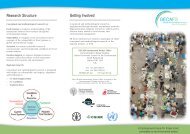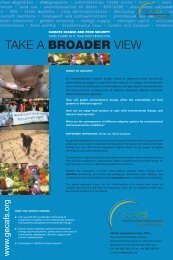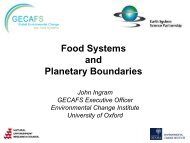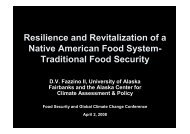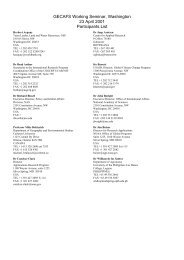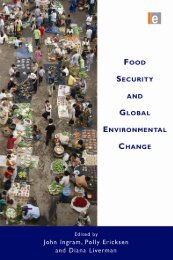Parry et al., 2005). Conducting food system research at the regional level also means that itcan address both rural and urban issues, and the relationship between them. Data collection isalso a challenge at regional levels if the region of interest includes parts, but not all of severalnations because data, especially economic and social, is often collected at the national leveland data systems may vary between countries.GEC/food security research at different scales and levelsThere have been a large number of experimental studies under the ‘food security’ banneraddressing food production. Most have addressed crop or animal productivity (i.e. yield), andhave reported research conducted at the experimental plot level (i.e. very local) over agrowing season or perhaps a few years. However, many of the issues related <strong>to</strong> regional foodproduction, and even more so <strong>to</strong> regional food security, operate at larger spatial and temporallevels, and warrant further research.Aware of the need for better links between agronomic research on crop productivity at plotlevel and regional production, and especially over time, the last decade or so has seenagronomists beginning <strong>to</strong> establish trials at landscape level (e.g. Veldkamp et al., 2001).Estimating regional production is not however just a matter of ‘scaling up’ plot-levelagronomic trials as the critically important social and institutional processes operating athigher levels need <strong>to</strong> be fac<strong>to</strong>red in. Put another way, studies that scale up from plot <strong>to</strong>regional level can be misleading at best and could lead <strong>to</strong> actions that impede real progress<strong>to</strong>ward food security unless social and economic components are at the heart of the process.Hence, a considerable methodological challenge <strong>to</strong> be overcome at such levels is foragronomists <strong>to</strong> work more effectively with economists and social scientists, as well as withsystem ecologists, <strong>to</strong> capture the key economic and social processes, as well as biophysicaland ecological processes at play at different spatial levels (Ingram et al., 2008). This includesnot only adopting a more interdisciplinary approach but also analysing interactions amongvariables from one level <strong>to</strong> the other. For instance, a decrease in maize yield at the plot orfield level may lead farmers <strong>to</strong> decide <strong>to</strong> shift <strong>to</strong> other crops (e.g. beans or cassava). If theshift is significant at the regional level, changes in the price of maize versus that of thealternative crops will take place. These changes in relative crop prices will trigger furtherchanges in farmers’ practices and in their adaptation of their systems <strong>to</strong> the market (Ingram etal., 2008). In contrast <strong>to</strong> agronomic studies, agricultural economic studies have oftenundertaken analyses at higher spatial levels, especially on economic and market implications,e.g. the Institute <strong>Food</strong> Policy Research Institute’s (IFPRI) IMPACT model (as discussed byRosegrant and Cline, 2003).Crop modellers have meanwhile been running simulations of crop yield over large areas forsome time. Early approaches (e.g. Rosenzweig and Parry, 1994) used point-based estimatesscaled-up using climate model output (which is only available at the higher level). Morerecent studies (e.g. Parry et al., 2005; Challinor et al., 2007) do model crop response at higher60
levels, but as they stress the influence of weather and climate, and their basis in observedrelationships, large-area crop models do not currently simulate the non-climatic determinantsof crop yield. These non-climatic stresses contribute <strong>to</strong> the yield gap (Challinor et al., 2009),i.e. the gap between potential and actual yields. However, as such models do not encompasschanges in the proportion of land under cultivation, it is not possible <strong>to</strong> estimate how regionalproduction will actually change. Certainly, reliable information is needed on plot-levelresponses <strong>to</strong> environmental stresses that can be scaled up geographically, but not in isolationfrom the other major regional drivers of food systems. Coupling models at different spatiallevels from plot <strong>to</strong> region allows the study of interactions and feedbacks among biophysicaland social components at different levels. There is therefore a need <strong>to</strong> design interdisciplinaryresearch that starts with GEC objectives at a regional level, and <strong>to</strong> build systems that facilitatebetter understanding of these interactions and feedbacks. The suit of ‘point’ (or plot-level)crop models now available (e.g. DSSAT, APSIM, SUCROS) provide a valuable foundationfor such work. Regional-level studies can be greatly facilitated, and very useful informationprovided <strong>to</strong> social and economic models, when the point models are integrated withdownscaled climate model results.Other modelling studies at regional level address how ‘mega environments’ for major cropswill change (e.g. for wheat, Ortiz et al., 2008b); and how the biogeography of major andlocally important crops, and crops’ wild relatives will be affected (e.g. Jarvis et al., 2008).Cross-scale and cross-level interactions are not, however, generally included in modellingstudies, other than where a spatial scale issue has direct relevance, as is increasingly the casefor multi-scale scenario studies (Ingram and Izac, 2010: Paper 6).In addition <strong>to</strong> considering ‘up-scaling’ research on food production, there is a need <strong>to</strong> alsoconsider research at more integrated levels for other aspects of the food system. <strong>Food</strong> s<strong>to</strong>rageis another key determinant of food security, and is especially important during times of stress.It is, however, a complex issue, crossing a number of levels on spatial, temporal andjurisdictional (and possibly other) scales. While research has addressed the issue of strategicfood reserves at village level (e.g. Mararike, 2001) and national level (e.g. Olajide andOyelade, 2002), there is insufficient research in<strong>to</strong> how best <strong>to</strong> establish long-term foodreserves at regional level. These could be a highly effective means of coping with impacts ofmajor droughts or other stresses that manifest at the regional level, but the issues are oftenhighly charged politically and progress can be slow. For instance, since the 1980s, SADC hasconsidered the establishment of a strategic food reserve <strong>to</strong> deal with the growing frequency ofnatural disasters. Early proposals were based on considerations of enough physical maizes<strong>to</strong>ck for 12 months’ consumption, but the SADC Council of Ministers have only recentlyagreed that the food reserve proposal should be revisited and should include consideration ofboth a physical reserve and a financial facility, supporting the notion of enhancedintraregional trade (Drimie et al., 2011).Other food system activities such as food distribution and logistics and consumption patternsalso warrant further analysis at regional level. An example of an initial analysis of currentknowledge and future research needs of all the major activities of the European food system61
- Page 1 and 2:
From Food Production to Food Securi
- Page 3 and 4:
From Food Production to Food Securi
- Page 5 and 6:
Table of ContentsAbstract .........
- Page 7 and 8:
Paper 6: Undertaking Research at th
- Page 9:
AbstractFood security is a conditio
- Page 12 and 13:
2010 about 925 million people had t
- Page 14 and 15:
water) are used, and reduce negativ
- Page 16 and 17:
While the flow of the argument abou
- Page 18 and 19:
determine interactions along and be
- Page 20 and 21: Paper 3: A Food Systems Approach to
- Page 23: From Food Production to Food Securi
- Page 26 and 27: concerns and are now issues that mu
- Page 28 and 29: the relationships between GEC and f
- Page 30 and 31: Theme 2 aims to understand how comm
- Page 32 and 33: GEC and the Food System of the Indo
- Page 34 and 35: Paper 2: The role of agronomic rese
- Page 36 and 37: These advances have resulted from a
- Page 38 and 39: Crop selection to determine mechani
- Page 40 and 41: Agronomic science is central to imp
- Page 42 and 43: Agronomic research in relation to f
- Page 44 and 45: The discussion above identifies a n
- Page 46 and 47: interventions and political inertia
- Page 48 and 49: While research on producing food ha
- Page 50 and 51: Box 1 Food system Activities and fo
- Page 52 and 53: In addition to broadening the debat
- Page 54 and 55: options. Examples already seen rang
- Page 56 and 57: Figure 3 Outcomes for 10 variables
- Page 58 and 59: Figure 4 Nine ‘planetary boundari
- Page 60 and 61: Figure 5 Environmental change, food
- Page 62 and 63: Table 1: Indicative analysis of the
- Page 65: From Food Production to Food Securi
- Page 68 and 69: Trade Agreement (NAFTA) and the Eur
- Page 72 and 73: is provided in the ESF/COST Forward
- Page 74 and 75: Paper 5: Engaging Stakeholders at t
- Page 76 and 77: into actions (strategies, policies,
- Page 78 and 79: Box 2 Engaging with stakeholders in
- Page 80 and 81: Box 3 Setting the research agenda f
- Page 82 and 83: Third, and of considerable practica
- Page 84 and 85: Figure 2: Organizing and understand
- Page 86 and 87: organizations made up of numerous n
- Page 88 and 89: Elements of good practice in stakeh
- Page 90 and 91: Finally, it is worth noting that fo
- Page 92 and 93: development (Lee, 1999; Gunderson a
- Page 94 and 95: Box 7 The GECAFS stakeholder survey
- Page 96 and 97: ‘break down’ what might be a hi
- Page 98 and 99: Paper 6: Undertaking Research at th
- Page 100 and 101: agriculture in many parts of the wo
- Page 102 and 103: gaps. The presence of a strong tech
- Page 104 and 105: an average of two years to coalesce
- Page 106 and 107: Institute for Meteorology and Hydro
- Page 108 and 109: Identifying case study sitesResearc
- Page 110 and 111: can both benefit from and contribut
- Page 112 and 113: Box 5 Mapping stakeholder interests
- Page 114 and 115: Holding planning meetings in locati
- Page 116 and 117: This reorientation of the debate fr
- Page 118 and 119: Importance of this type of research
- Page 120 and 121:
Integrating the food system concept
- Page 122 and 123:
awareness of the GEC issues within
- Page 124 and 125:
pollutants were then introduced as
- Page 126 and 127:
communities operating in food syste
- Page 128 and 129:
Improving input-use efficiency acro
- Page 130 and 131:
governance focuses on the range of
- Page 132 and 133:
Developing research agendas in supp
- Page 134 and 135:
The renewed approach to interdiscip
- Page 136 and 137:
BIELAK, A., HOLMES, J., SAVGÅRD, J
- Page 138 and 139:
EAKIN, H. 2010. What is Vulnerable?
- Page 140 and 141:
GODFRAY, H. C. J., BEDDINGTON, J. R
- Page 142 and 143:
INGRAM, J. S. I. & FERNANDES, E. C.
- Page 144 and 145:
LYUTSE, S. 2010. The One Billion To
- Page 146 and 147:
RAYNER, S. & MALONE, E. L. 1998. Hu
- Page 148 and 149:
UNDP 2006. The 2006 Human Developme
- Page 150 and 151:
activities “from plough to plate
- Page 152 and 153:
contribution to the science agenda:
- Page 154 and 155:
urgently needed, and - given the gr
- Page 156 and 157:
GECAFS plannenmakerij stelde vast d
- Page 158 and 159:
ieder hun eigen groep van betrokken
- Page 160 and 161:
het gebied van beheer hebben betrek
- Page 162:
Curriculum VitaeFollowing a BSc in



